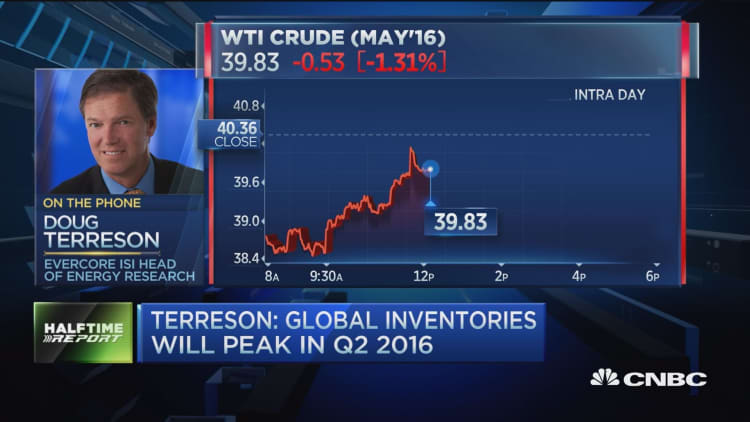Oil prices have rebounded above $40 a barrel since striking 12-year lows earlier this year, but the outlook for Big Oil earnings remains bleak.
The biggest "integrated" oil companies — those with both exploration and refining operations — have begun to close the gap between spending and income by cutting costs and laying off workers. But the earnings from Big Oil and their smaller integrated peers will reflect the low prices for oil, as well as the waning benefit of downstream refining operations.
Analysts are once again expecting steep declines in profit and revenues.
Six of the biggest oil companies — Chevron, Exxon Mobil, Royal Dutch Shell, ConocoPhillips, BP and Total — collectively shed more than $200 billion in market capitalization last year, according to CNBC analysis of FactSet data.
In the final quarter of 2015, BP reported its worst annual loss in two decades. Chevron posted its first quarterly profit decline in 13 years. ConocoPhillips delivered larger-than-anticipated loss and slashed its dividend by two-thirds.
Exxon Mobil's quarterly profit sank as well, but the energy giant outperformed its peers thanks in large part to strong performance in its chemicals business.
Sam Margolin, director of equity research at Cowen and Co., said it would be another tough quarter for integrated oil and gas, but stocks seem to be looking through first-quarter results.
"I'm not sure if there's a whole lot more spending and costs to cut out, so it's going to be a lot of focus on commodities and optimizing operations in the lowest-cost areas," he told CNBC.
In a note, Cowen said the majors should be able to sustain their dividends through 2017 as commodity prices recover and the companies continue to get more efficient, cut costs, and sell assets. The firm sees free cash flow improving and the industry closing its funding gap by mid-2017.
Piper Jaffray expects integrated oil companies to make progress toward becoming cash-flow neutral — or able to fund their business with revenue from operations. The firm now believes they need oil to average $58 a barrel in 2017 — down from an earlier estimate of $73 — in order to reach that goal.
But Piper cautions that cash flow weakness could surprise the Street this quarter, particularly in the case of Chevron, ConocoPhillips and Hess. The firm's earnings-per-share and cash-flow-per-share projections for the industry are 6 percent and 7 percent below consensus, respectively.
"Full-scale cash crisis"
Schlumberger Chairman and CEO Paal Kibsgaard echoed that sentiment last week when the oilfield services executive said the industry "displayed clear signs of operating in a full-scale cash crisis."
"This environment is expected to continue deteriorating over the coming quarter given the magnitude and erratic nature of the disruptions in activity," he said in Schlumberger's earnings release.
As crude prices have moved higher, the S&P 500 energy sector has rebounded since January. It is now the second-best performing industry in the index, up nearly 10 percent this year.
Fundamentals are improving in Piper Jaffray's view, but integrated oil stocks look expensive following a 30-percent rise in share prices among companies it covers. Crude needs to reach $70 per barrel in 2018 in order for valuations to look more reasonable, it concluded.

Piper's top pick is Canada's Suncor Energy, based on its financial resilience and free cash flow expansion.
Doug Terreson, head of energy research at research firm Evercore ISI, said he still likes big oil, but partially because dividend yields of 4 to 8 percent look resilient in a lackluster market.
"The Evercore ISI view is that the market is going to be flat this year, and those stocks will prove pretty defensive in that scenario, and that's especially true if the oil price rises as we expect" to $45 to $50 per barrel by the end of 2016, he told CNBC's "Fast Money: Halftime Report" earlier this month.
Terreson has "buy" ratings on shares of BP, Chevron, and Exxon.
Refining profits "even more important"
Analysts warned of headwinds to refining operations, which have buoyed integrated energy firms as upstream production revenue has fallen. Refinery profit margins expanded earlier in the downturn as the price of oil — the feedstock for gasoline and diesel fuel — fell.
"One of the key themes this quarter is likely to be downstream exposure, with refining margins down to more 'normal' levels for the first time during this down-cycle," RBC Capital Markets said in a note. "For 2016, assuming our $43 (per barrel) oil price forecast, we assume upstream divisions for some of the majors could be loss making, which makes downstream earnings composition even more important, in our view."
RBC sees Chevron, Repsol, and BP as most exposed to weakness in refining margins, and Statoil and Eni least exposed.




